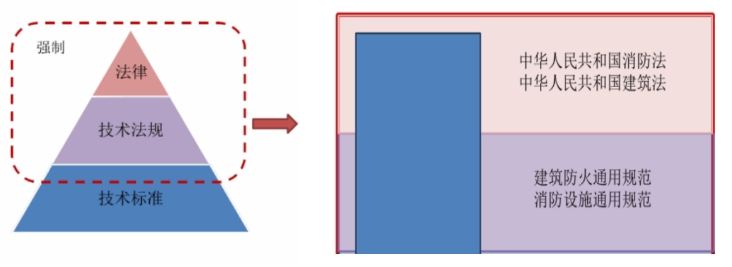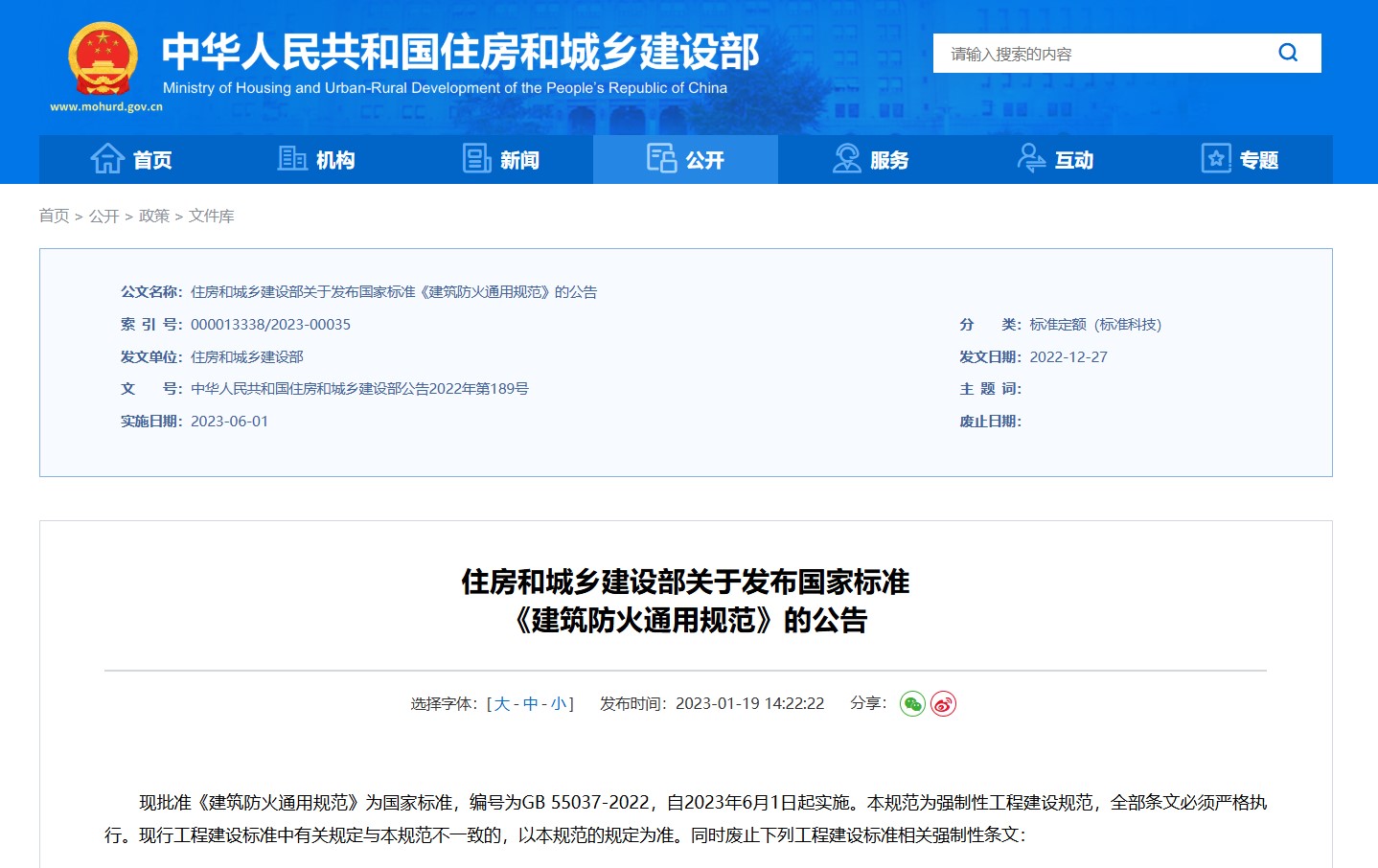A brand-new interpretation of the "General Code for Fire Protection in Buildings" (GB 55037-2022)
Standardized system positioning
Since 2016, in order to adapt to the prevailing rules of international technical regulations and standards, the Ministry of Housing and Urban-Rural Development has successively issued documents such as the "Opinions on Deepening the Reform of Engineering Construction Standardization Work", putting forward the long-term goal of the government formulating mandatory standards and social organizations formulating voluntary adoption standards. The reform task of gradually replacing the scattered mandatory provisions in the current standards with full-text mandatory engineering construction norms has been clearly defined. A "technical regulation" system composed of technical provisions in laws, administrative regulations, and departmental rules and full-text mandatory engineering construction norms has been gradually formed. Since 2021, 40 full-text mandatory engineering construction norms have been successively approved and released. "General Code for Fire Protection in Buildings" (GB 55037-2022) (hereinafter referred to as the "Code") is one of them.

"Technical Regulations" system diagram
The release of norms
On January 19, 2023, the Ministry of Housing and Urban-Rural Development of the People's Republic of China issued Announcement No. 189 of 2022, approving the "General Code for Fire Protection of Buildings" as a national standard, with the number GB 55037-2022, which will come into effect on June 1, 2023. This specification is a mandatory engineering construction standard, and all its provisions must be strictly implemented.

The main contents of the norms
This specification is applicable to all types of above-ground and underground industrial and civil buildings, including various types of housing buildings, rail transit projects, urban traffic tunnel projects, highway tunnel projects, civil air defense projects, gas and hydrogen refueling stations, pipe galleries or common trenches and cable tunnels, as well as other municipal projects and facilities, various production facilities, towers and silos and other structures. It is not applicable to storage tanks or tank areas for flammable gases and liquids, flammable material storage yards, container storage yards, nuclear power projects and their buildings, military buildings and projects, mining projects, buildings and projects of explosives and fireworks and firecrackers and other pyrotechnic products.
The main contents of the specification are:
1. The goals and functions of building fire prevention and the basic regulations of fire rescue facilities;
2. General requirements for the overall layout of buildings, fire protection distances between industrial buildings and civil buildings, and basic requirements for fire rescue;
3. Basic requirements for building floor plan layout and fire separation;
4. Functional and performance requirements for fire resistance of building structures;
5. Functional and performance requirements for fire protection in building structures and decoration;
6. Functional and performance requirements for safety evacuation and refuge facilities;
7. Functional and performance requirements for the locations where fire protection facilities are set up;
8. Functional and performance requirements for fire protection in heating, ventilation and air conditioning systems;
9. Functional and performance requirements for electrical fire protection;
10. Functional and performance requirements for fire protection in building construction;
11. Functional and performance requirements for fire protection in building use and maintenance.
The main technical requirements of the specification have changed
The main goals of building fire protection and the functional goals and main performance requirements of each
subsystem in the building fire protection system have been clearly defined.
2. The bottom-line requirements for each fire protection subsystem have been clearly defined;
3. The determination principles of important fire prevention technical measures such as fire separation distances,
fire compartment divisions, evacuation distances, and the setting of fire protection facilities have been clearly defined.
4. The fire separation distances in crowded places have been adjusted.
5. The principles for determining the fire protection standards for the renovation of existing buildings and the fire
protection requirements for areas with a high density of existing buildings have been clarified.
6. The system has improved the requirements for fire rescue facilities.
7. The requirements for the setting of personnel evacuation and refuge facilities have been improved and strengthened.
8. The fire resistance requirements for structures have been strengthened, clearly requiring the verification or validation
of the fire resistance performance of building structures.
9. The scope of installing automatic fire alarm systems in civil buildings has been expanded.
10. The basic functions, performance and the basic fire resistance performance requirements for different installation
positions of various types of fire doors, fire Windows and fire glass walls have been clearly defined.
11. The requirements for setting fire compartments and safety exits in warehouse buildings have been adjusted.
12. The requirements for the rooms of boilers and diesel generators have been adjusted.
13. The relevant fire protection requirements for buildings with heights greater than 100m, 150m and 250m have been
appropriately raised, and the requirements for the setting of fire protection facilities and signs have been strengthened.
14. The basic requirements for the fire communication and command system have been added;
15. Other details have been perfected.
The relationship with current technical standards
The notice issued abolished the mandatory provisions of the corresponding standards, including the provisions and their mandatory nature. During the transitional stage when the relevant standards have not been revised, only the mandatory nature was abolished. During the implementation process: when the original standard provisions do not overlap, conflict or are not lower than the provisions of the norms, the original provisions are retained but are recommended provisions. When the original standard provisions overlap with the normative provisions, when revising the relevant technical standards, the general norms should be directly cited or deleted. When the original provisions are in conflict with the norms, inconsistent or lower than the provisions of the norms, the original provisions shall be abolished.
Precautions during the execution process
For fire protection facilities and fire prevention technologies not explicitly stipulated in the code, during construction, use and maintenance, the requirements for their design, construction, acceptance, use and maintenance should be determined in accordance with the basic requirements of Chapter 2 of the code and the functional, performance requirements and technical standards of the corresponding fire protection facilities or building fire protection systems.
In a construction project, whether the fire protection facilities set up or the fire protection technologies adopted comply with the requirements of the code should be determined based on the basic requirements of the corresponding fire protection facilities or fire protection technologies stipulated in the code. The functional goals of such fire protection facilities or technologies should be set, and they should be judged according to the performance and functions they can possess. On this basis, the corresponding technical performance and related parameter indicators should be determined.
The release of this new regulation marks that China's building fire protection standards have entered a new stage that is more scientific and practical, and will significantly enhance the overall level of fire safety.
